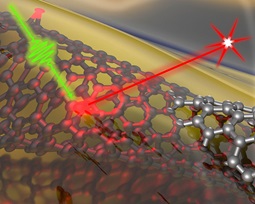A US-France-Germany collaboration has led to some intriguing work with carbon nanotubes. From a June 18, 2018 news item on ScienceDaily,
Researchers at Los Alamos and partners in France and Germany are exploring the enhanced potential of carbon nanotubes as single-photon emitters for quantum information processing. Their analysis of progress in the field is published in this week’s edition of the journal Nature Materials.
“We are particularly interested in advances in nanotube integration into photonic cavities for manipulating and optimizing light-emission properties,” said Stephen Doorn, one of the authors, and a scientist with the Los Alamos National Laboratory site of the Center for Integrated Nanotechnologies (CINT). “In addition, nanotubes integrated into electroluminescent devices can provide greater control over timing of light emission and they can be feasibly integrated into photonic structures. We are highlighting the development and photophysical probing of carbon nanotube defect states as routes to room-temperature single photon emitters at telecom wavelengths.”
A June 18, 2018 Los Alamos National Laboratory (LANL) news release (also on EurekAlert), which originated the news item, expands on the theme,
The team’s overview was produced in collaboration with colleagues in Paris (Christophe Voisin [Ecole Normale Supérieure de Paris (ENS)]) who are advancing the integration of nanotubes into photonic cavities for modifying their emission rates, and at Karlsruhe (Ralph Krupke [Karlsruhe Institute of Technology (KIT]) where they are integrating nanotube-based electroluminescent devices with photonic waveguide structures. The Los Alamos focus is the analysis of nanotube defects for pushing quantum emission to room temperature and telecom wavelengths, he said.
As the paper notes, “With the advent of high-speed information networks, light has become the main worldwide information carrier. . . . Single-photon sources are a key building block for a variety of technologies, in secure quantum communications metrology or quantum computing schemes.”
The use of single-walled carbon nanotubes in this area has been a focus for the Los Alamos CINT team, where they developed the ability to chemically modify the nanotube structure to create deliberate defects, localizing excitons and controlling their release. Next steps, Doorn notes, involve integration of the nanotubes into photonic resonators, to provide increased source brightness and to generate indistinguishable photons. “We need to create single photons that are indistinguishable from one another, and that relies on our ability to functionalize tubes that are well-suited for device integration and to minimize environmental interactions with the defect sites,” he said.
“In addition to defining the state of the art, we wanted to highlight where the challenges are for future progress and lay out some of what may be the most promising future directions for moving forward in this area. Ultimately, we hope to draw more researchers into this field,” Doorn said.
Here’s a link to and a citation for the paper,
Carbon nanotubes as emerging quantum-light sources by X. He, H. Htoon, S. K. Doorn, W. H. P. Pernice, F. Pyatkov, R. Krupke, A. Jeantet, Y. Chassagneux & C. Voisin. Nature Materials (2018) DOI: https://doi.org/10.1038/s41563-018-0109-2 Published online June 18, 2018
This paper is behind a paywall.
